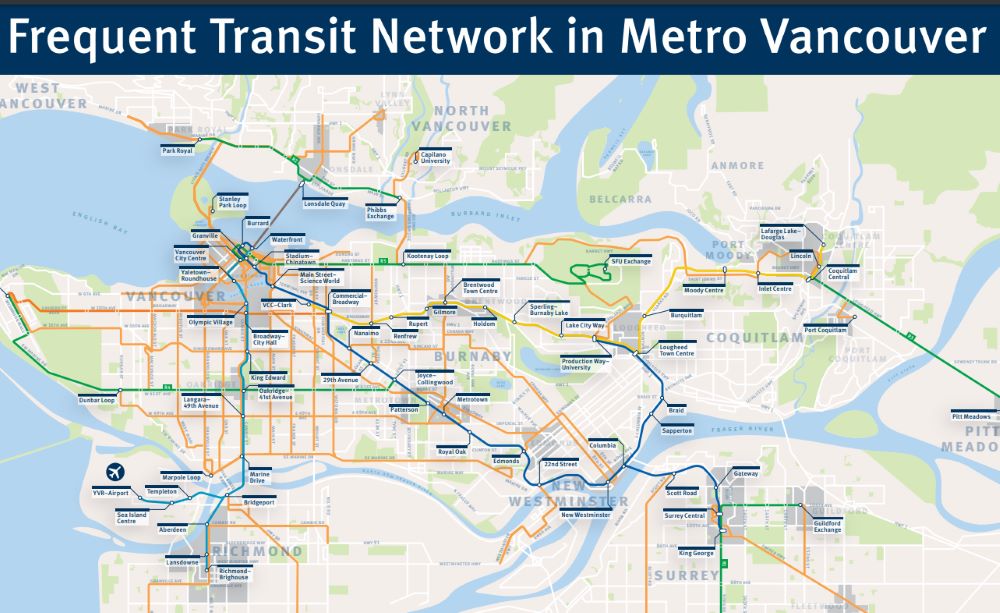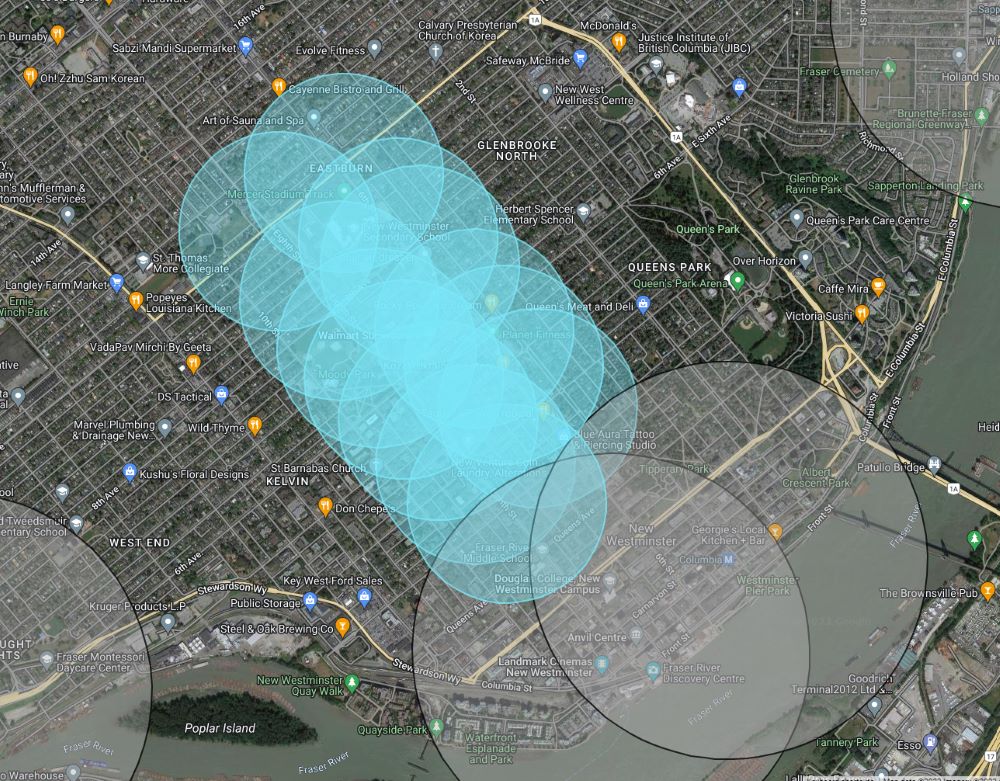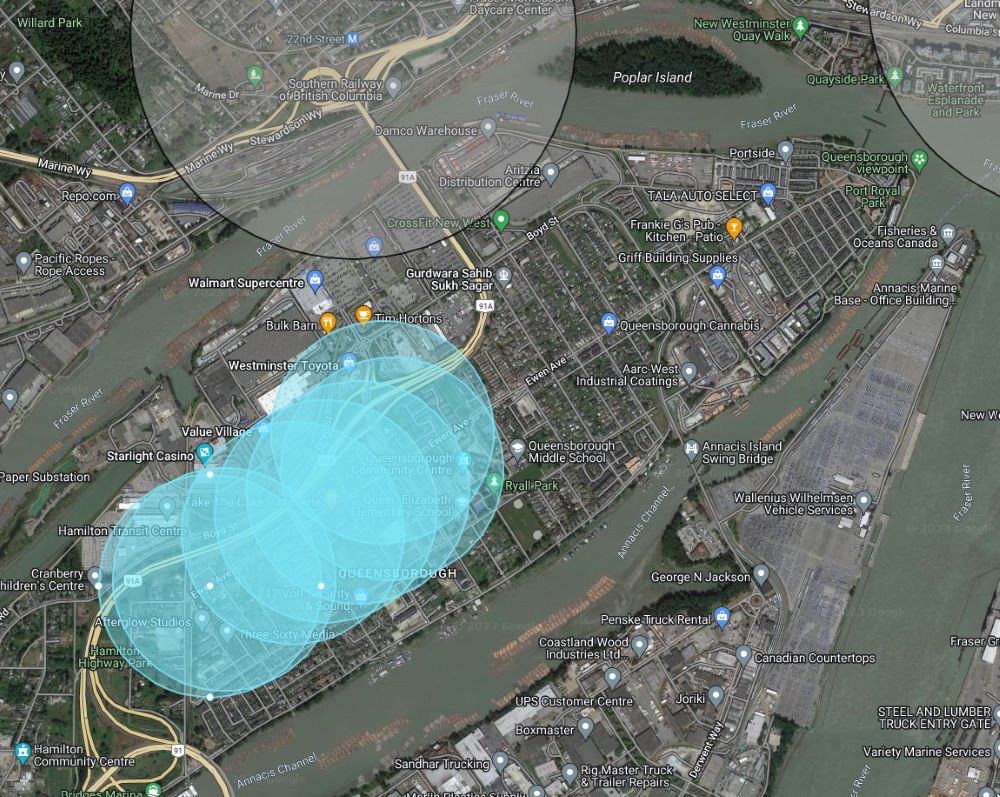I’m writing a series of posts about the recent changes the provincial government has introduced to drive the development of new housing in the region and province. In the first post, I wrote about Bill 44 and multiplexes, and some of the complications of putting 4-plexes on lots across New West. I sort of skipped past the 6-plex part of the story. While 4-plexes will be permitted on all “single family” lots in New West, the bill also suggests 6-plexes will be permitted on all residential lots near Transit stops with Frequent Service.
This may shake out in details, but it looks like “near” will mean within 400m, and I have no reason to believe the Province won’t apply TransLink’s “Frequent Service” designation, as show on this map:

I quickly drew 400m radius circles around Frequent Transit Service stops in New Westminster. By my admittedly preliminary assessment, all of New Westminster covered in blue here will be pre-approved for six-plexes:

Note this is a significant part of the Brow of the Hill, Moody Park, Queens Park, Glenbrook North, and Queensborough. The unshaded areas will be permitted four-plexes in all residential zones under Bill 44. The gray-shaded areas are Transit Oriented Development areas that we’ll discuss when I get to Bill 47 in the next Blog Post. But first, let’s look at:
Bill 46: Paying for growth!
This Bill recognizes that local governments use the power of zoning to pay for infrastructure required to support that growth. With a de-emphasis on zoning, this raised some significant concern about how we will pay for the infrastructure needs that will only increase as we rapidly build new housing. This Bill both gives local governments more tools to do that, while also taking away some other tools.
The biggest tool local governments have for raising money for growth-supporting infrastructure is the Development Cost Charge, or DCC. This is a very prescriptive tool, and most large and medium-sized cities use it in some form, as do Metro Vancouver. In New Westminster, we use it for sewer, drainage, and water utilities, and for park space expansion. It works like this:
A local government identifies through its OCP the amount of growth the community or a neighbourhood will see in the decades ahead. They then evaluate some utility projects that will be needed to support that growth: bigger water pipes, bigger sewer pipes, pump stations, etc. They then (and this is important) plan and budget those improvements. They then make some determination of what percentage of the cost of that project should be allocated to new growth, and what percentage should be charge to existing users, after all we need to replace infrastructure occasionally even without growth.
So lets assume (and all of these numbers are false for simplicity, used just for example) we expect 10,000 new units in Queensborough in the next 20 years, and to support those we need to spend $20 Million in sewer upgrades. We could assume 50% of this cost should go to existing users, so we need to raise $10 Million in DCCs from those 10,000 units. We then apply a $1,000 DCC to each of those new units, and the developer pays that to the City before they are permitted to build. Meanwhile, sewer utility rates go up in the neighbourhood to collect the other $10 Million from existing users. The City puts that collected money in an earmarked reserve, and can only spend it on that sewer project.
Under the current legislation, Local Government can only collect DCCs for specific uses: mostly water, sewer, drainage, roads, and parks acquisition. Bill 46 adds other infrastructure to the pool of things Local Governments can fund through DCCs, including fire halls, police facilities and solid-waste facilities. This is good if you are of the belief that “Growth should pay for Growth”, though the jury is still out on that assumption.
Another tool local governments use to fund infrastructure and amenities in their community are the slightly-misnamed Voluntary Amenity Charges. As its basic level, this is a cash payment developers make to local governments to sweeten the pot of approving a development. Cities are not allowed to demand these (“voluntary” is right in the name!), but they are allowed to suggest what an appropriate contribution might be, based on the size of the development. Developers could offer it or not, but when Cities ultimately can say “no” to rezoning any development, it starts to not sound so voluntary. And to many, it sounds pretty shady. So Bill 46 is going to do away with VACs. Whether that is good or bad depends on how the City has used them, I suppose.
The City of New Westminster is pretty transparent when it comes to VACs and base expectations on the type of development and location. The City and Developer also commonly work together to develop pro forma estimates of the value of land lift the City is giving a developer when they grant rezoning for larger density projects. The City expects some amenity for the community to come from that “land lift” value. If we are increasing the value of a developer’s land by Millions of dollars when giving them rezoning, the City wants its pound of flesh. Maybe the developer provides a childcare space for a non-profit, or park trail improvements by their property, or a portion of the development be given to a non-profit for affordable housing. These are the kinds of negotiations that happen typically at Rezoning. The VACs are part of that amenity package that the City uses to assess if the community got its share. The City of New Westminster does not put and cash received as VAC into general revenue, but puts it in pre-established reserve funds to pay for everything from Affordable Housing to Childcare to Public Art.
Bill 46 plans to do away with this, and with so much density increase not relying on rezoning, the lever we have as a local government to demand expect Voluntary Amenity Charges is going away anyway. The Province recognizes this and is bringing in a new tool called Amenity Cost Charges. In short, it looks like ACCs are going to operate more or less like DCCs, but will be applicable for a wider range of purposes, including those that VACs often funded, like community and recreation centres and libraries.
The positive side of this is that the charges will be more predictable and earmarked for specific uses, creating a more transparent process. The downside is that local governments will lose some flexibility in how these funds are used – we can’t load up a VAC reserve and apply it to a library or piece of public art or playground enhancements when we feel like it, but must pre-determine and cost the projects that will be funded. That planning a decade or more ahead on community needs and putting a projects cost on them is actually a LOT of technical work for staff in Planning, in Engineering, in Parks, in the Library, etc.
Ultimately, the increased transparency and predictability comes at the cost of more oversight and work required by staff, and perhaps some loss of flexibility in how a community decides to develop amenities. Overall, though, I think it is a better way to do governance and it creates more certainty for the development community and the community at large. If I have a concern it is in our ability to staff up that planning work in time to assure we collect sufficient ACCs if the Transit Oriented Development changes in Bill 47 lead to a building boom. Which I will write about in the next post.